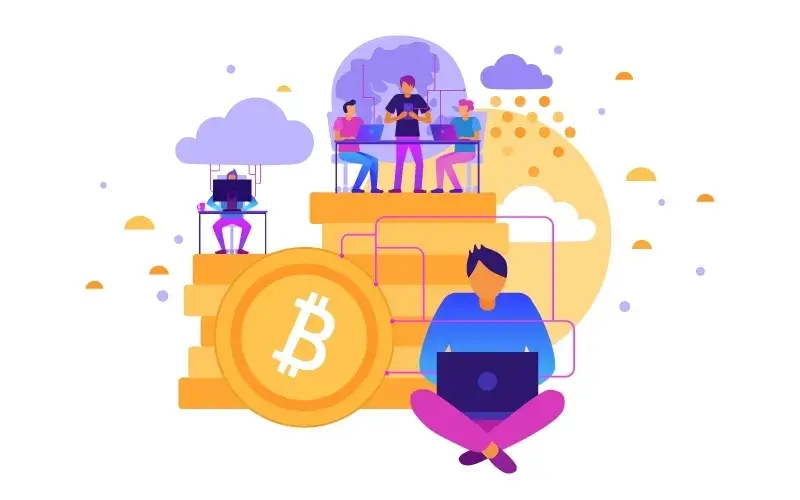Even though the internationalisation of blockchain technology appears promising, it may not solve every business issue we face. Blockchain adoption has faced challenges even if almost everyone knows some blockchain-related terms like “Bitcoin”, and the technology is ready to help many businesses.
Before we start discussing issues, let’s understand what blockchain is.
What is Blockchain?
Most of us think of blockchain as a cryptocurrency because when we think about blockchain, the first word that comes to mind is Bitcoin.
However, these are two different things. Cryptocurrency is a product that utilises the blockchain as a system.
A blockchain is a shared distributed database or ledger between computer network nodes. A blockchain serves as an electronic database for storing data in digital form.
A blockchain is a network of nodes. Nodes are hardware components that use software to connect to that blockchain. Nodes verify every data exchange or transaction that takes place on the blockchain. Since anyone can set up and manage a node on most public blockchains, blockchain is a decentralised and open system.
Blockchain is used for more than just digital coins, even though that may be its most popular application. Some have created blockchains that can exchange data in many forms, including tokens, documents, videos, and images.
It is challenging for hackers to spoof transactions because of the entire operation. Anyone who wants to amend a single transaction must edit all of the blocks that come after it in the chain. And the relevant block is stored in each blockchain node separately (or rejected entirely). That is what is most crucial in this situation. However, everything has drawbacks, and let’s explore those further.
Common Issues Arising in Blockchain
 https://www.freepik.com/free-vector/_17962370.htm
https://www.freepik.com/free-vector/_17962370.htm
-
Transaction Speed
Slow transaction speeds are an ongoing issue posing a serious barrier to the widespread adoption of blockchain technology. Blockchain is a decentralised system; therefore, before a transaction can be acknowledged as a block, the nodes must verify it.
Think about how quickly transactions are completed with Bitcoin compared to companies like Visa. Only 4.6 transactions per second are currently possible with Bitcoin. While Visa, on the other hand, typically processes 1,736 transactions per second (Calculated based on the official claim of 150 million transactions per day). Many firms and organisations are accelerating blockchain transaction speeds, but each approach has its drawbacks.
-
Scalability
A blockchain becomes increasingly insecure as it becomes more prominent.
Blockchains are full of challenges to grow due to their redundancy. From the genesis block to the most current transaction, every device in your network must have a copy of every action taken. That entails reproducing the same data hundreds of times!
It necessitates vast storage, and the larger the blockchain, the more processing power the nodes require.
And even if all your hardware, software, and digital demands are met, controlling your blockchain will be nearly impossible.
-
Security
No matter how secure they appear, blockchains are only as secure as their weakest link. For instance, one node is all that is required for someone to access data shared within a private blockchain.
That means that a blockchain’s most easily compromised device puts the privacy of the entire blockchain at risk. Sadly, blockchains also have additional problems.
While forging a transaction in a blockchain may be next to impossible, it is nevertheless feasible to have a fraudulent transaction authorised.
-
Transparency
Using public blockchain (The most common option.) in a business setting isn’t necessarily a good choice. Why? Because if a supply chain is transparent, all of the customer and partner data associated with that business will also be.
Complete transparency isn’t desirable when working in a professional setting because it allows participants to view each other’s activities in real-time.
Private blockchains, which can limit who can join as a node and who can access certain transactions, can reduce public trust in the product because they aren’t genuinely decentralised.
-
Regulations
The network’s decentralisation of authority means that there is no single power to enforce law and order. There are no moderators, leaders, or even oversight organisations!
Not to add that smart contracts, agreements created on a blockchain, are typically not regarded by law as binding agreements or proofs.
Which laws should govern smart contracts, agreements, transactions, and cases if every user may be from a different nation and blockchain transcends all borders?
The absence of global standards exposes developers to risks and difficulties in building blockchain-based solutions across diverse platforms.
-
Energy Consumption
Blockchain technology necessitates more storage than any other system. The number of nodes added to a blockchain multiplies the electricity required, and each node stores and processes almost as much data as any other system’s central hub.
Although blockchain technology has issues, many individuals are working on fixes. The current solutions appear to deviate slightly from the initial blockchain concept outlined in the Bitcoin white paper published more than ten years ago. Developers will discover dozens more applications for blockchain technology as the market and technology advance.
Blockchain promises to increase the speed and security of multiple data transport and storage procedures. Despite the issues it may currently have, there will inevitably be more reasons to embrace blockchain as a solution as our lives become more digital.
You can get in touch with Sanmark Solutions to overcome the issues mentioned above. We are prepared to assist you.
Feature image source: https://www.freepik.com/free-photo/_15559147.htm

Leave A Comment